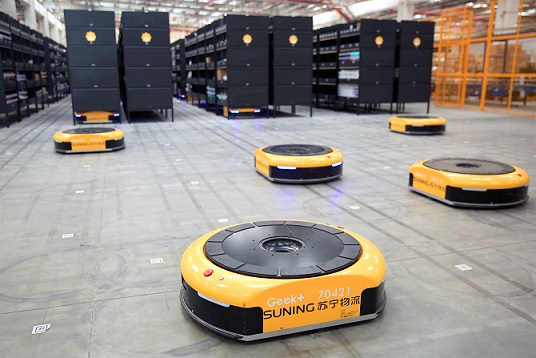
New study: Mobile robots in logistics centres to exceed $3 billion in 2022
Automated guided vehicles (AGVs) and autonomous mobile robots (AMRs) used in logistics applications are forecast to enjoy massive growth in the next five years and grow ten-fold to exceed $3bn in 2022, according to a new report from Interact Analysis.
Despite the market being worth just $300m in 2017, the report forecasts that more than 400,000 mobile robots will be installed by the end of 2022.
Whilst AGVs have long been used in manufacturing environments to lower costs and improve efficiencies, logistics and fulfilment centers are a relatively new opportunity.
“The proliferation of ecommerce, omnichannel retailing and customer demands for faster and cheaper delivery are forcing logistics providers to look to automation to ease the pressure,” said Ash Sharma, Research Director at Interact Analysis.
“These demands are compounded by a shortage of available workers, the time needed to train new employees and increasing wage costs. All these factors combined are driving up the ROI for mobile robots and shortening the payback time to under a year in some cases.”
Given these underlying macro-drivers and the massive growth forecast for the future, investment dollars have been flowing into the growing number of mobile robot vendors coffers. Both Fetch Robotics and Locus Robotics raised $25m each in recent months, says the report.
Dozens of mobile robot companies have emerged since the acquisition of Kiva Systems by Amazon in 2012, and the subsequent technology vacuum that resulted.
Many of the companies – all from Asia – have gone to market with a similar product and solution as Kiva. Whilst they’re seeing initial success, and indeed the report forecast substantial growth in the next couple of years, this growth may be short-lived with other approaches set to surpass them, says the report.
“The ‘Kiva’ approach of moving mobile racks around a fulfilment center requires substantial infrastructure changes and so is not always well suited for brownfield sites, or for smaller customers that wish to avoid such large capital investment and disruption to their operations” said Sharma.
The report found a more promising outlook for collaborative mobile robots, which can work in partnership with human workers to improve throughput and at the same time ease the demands coming from labour constraints.
AMRs that improve throughput through guiding human pickers, and those that replace manual forklifts and trolleys are tipped for robust growth. Robots – which can be deck-load, tuggers or forklift in design – can be added in phases and scaled after an initial pilot, and in-line with the customers growth in a less capital intense way.
Multi-national logistics companies such as DHL and FedEX have been deploying mobile robots (from multiple vendors) over the past couple of years and this rollout is likely to accelerate.
Similarly, major Chinese ecommerce companies have also begun adopting mobile robots in their facilities. Many of the Chinese companies deploying mobile robots are only now building out their logistics infrastructure and the complexity and cost of incorporating mobile robots and automation within greenfield sites is considerably lower than for existing warehouses.
Alibaba for instance has deployed 100 Quicktron robots at a single facility and many more are likely in the next 18 months. Furthermore, the report revealed that the Chinese (logistic) mobile robot market is forecast to almost triple in size in 2018.
The deployment of such robots is forecast to save the logistics industry over $4bn in direct labour costs by 2022, even after the additional costs of the robots and associate infrastructure are deducted.
Close to $7bn in total will be saved over the next five years according to the report. Assuming that more than 400,000 mobile robots will be in operation by the end of 2022, a similar number of human roles (or openings) could be eliminated from the logistics sector leading to an annual saving of more than $4bn.
The Mobile Robots – 2018 report, which features more than 100 pages of analysis and 65 data tables and forecasts was published in March 2018.


